Coronavirus (COVID-19) community resilience in Scotland's islands: research
The challenges presented by the Coronavirus (COVID-19) pandemic have prompted extraordinary responses from many communities across Scotland, including the islands. It is this response – and the networks that supported it and stemmed from it – that this research seeks to explore and learn from.
Broadford and Strath Community Company
Introduction
Broadford and Strath Community Company (BSCC) covers a large area in the south of Skye, stretching from the large population centre of Broadford to Elgol 14 miles away[25]. While Broadford is on the main road from the Skye Bridge to the island's capital, Portree, much of the rest of the area is reachable only by single track road. Broadford and Strath, already a large area, seemed to become an even bigger area when the COVID-19 pandemic first hit because of the transport infrastructure.
The population of the area is around 2,000 people, but because Skye is a popular tourist destination, there is considerable variation in population over the year, in "normal" times. In the year prior to lockdown, tourism generated an estimated £211 million for the island, from an estimated 650,000 visitors.[26] Tourism is believed to support nearly 3,000 jobs for Skye and Raasay residents, and so lockdown had a significant economic impact of the island. The unemployment claimant rate in the Portree TTWA (travel to work area) increased by 421% in March to July 2020.[27]
Who was involved
BSCC evolved from the Broadford Environmental Group and bought a local community woodland about 10 years ago. Since then, its activities have expanded considerably. As well as managing the woodland as a forestry resource they also raised funding to establish a campsite with electric hook-up points in the woodland. Camping Skye is now up and running and is one of their largest projects, redistributing any profit made back to the charity for its charitable purposes. They maintain a community garden in Broadford, an extensive path network in Broadford and Strath, and manage the Growers Hub which includes eight polytunnels and allotments, a Men's Shed, Flourish (a horticultural therapy group), and offer community growing and outdoor learning opportunities. BSCC is currently engaged in building new public toilets in both Broadford and Elgol and developing a safe route for walkers and cyclists from the Skye Bridge to Broadford. Many of their normal operations and income generation were impacted negatively by the pandemic.
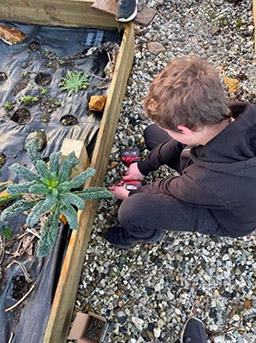
BSSC currently has 24 sources of funding, and has 13 employees, most of whom are part time and dedicated to specific projects. They also have a bank of volunteers, which expanded considerably during the pandemic. The pandemic response of BSCC mainly centred around the provision of food and cooked meals to people across the BSCC area.
In addition to BSCC and its bank of volunteers, the food initiatives they co-ordinated involved various other local businesses/organisations with whom they worked in partnership for different aspects:
- the south end branch of The Community Foodbank – Skye and Lochalsh
- the Broadford Co-op and other local shops
- the local primary school (especially the school catering staff)
- a local hotel owner
- a local estate agent
The general initiative was aimed at anyone living in the BSCC area, although some aspects of it were more targeted in one way or another. For instance, those who were elderly, people shielding, socially isolated people (because of location or circumstance), and those likely to be in food poverty.
Why the project started
As an environmental group, BSCC had had a growing project up and running for a number of years, both in terms of leasing polytunnel/allotment space to locals and also growing food for distribution themselves. This latter aspect was largely managed by volunteers. The garden area, known as the Growers Hub, was also used by other local groups (such as Flourish) and the local school children, all of whom would work in the garden and also take some of the produce that was grown. Social distancing restrictions during lockdowns meant that these groups were unable to access the gardens, and as the first lockdown coincided with the peak growing period, it was important that no produce went to waste.
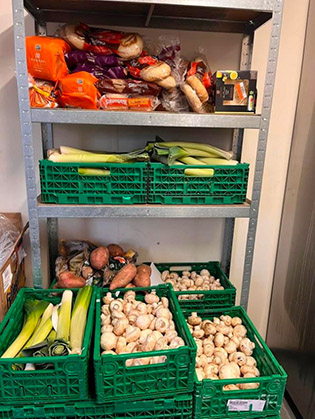
At the start of 2020, a local woman was in the process of setting up the south end branch of The Community Foodbank – Skye and Lochalsh. In parallel, the manager of the local Broadford Co-op had also expressed interest in finding someone to work with to reduce the food waste from the shop and using it to address food need in the community. He approached the foodbank who in turn approached BSCC. The foodbank was able to take some of the surplus food, and BSCC set up a "Food Share" to take the rest, to avoid food waste. Prior to this, the surplus food would go into a skip and ultimately to landfill. The Co-op were aware that there were 'skip-divers' searching the skips at night for food, because of food poverty.
"BSCC created a daily Food Share where we would take all the food waste from the Co-op and share it at the, now closed due to Covid, community campsite. After seeing how successful it was we then moved it to the more central location at the Broadford Village Hall…At the start we thought it would last a few months however very quickly we realised that this wasn't just a Covid issue but an ongoing issue and the project would be a long term one."
What the project involved
The Co-op manager had already offered storage space within the store to help the foodbank get started in the early part of 2020, but the BSCC "Food Share" did not have any permanent space at all. BSCC quickly saw the benefits of working with the foodbank to bring together their own produce from the Growers Hub with the supermarket surplus and make it available for anyone that could make use of it during lockdown. This was done partly through establishing collection points around the BSCC area, and the foodbank volunteers organised deliveries to those who were not able to attend the collection points. BSCC recruited a team of volunteers to help with collection and distribution of the waste food. These volunteers were offered their fuel costs but all of them declined to claim any expenses. Eventually, with the support of a Project Officer, BSCC found a more permanent space for the Food Share and the foodbank, albeit on a temporary basis, and with Supporting Communities funding from Scottish Government BSCC also purchased a storage container, larger fridges and a freezer to enable them to store any surplus food. Funding also got them an additional polytunnel for further community growing.
"The manager of the local Co-op in Broadford was very positive about food need and ending food waste in the community, he was quite a driver actually and he offered us space for the foodbank within the Co-op so we had a store room and somewhere to distribute parcels from."
The role of BSCC staff and volunteers was to collect the food from the supermarket and put it together with the surplus produce from their own growing area and leave it where it could be collected by anyone that needed it. In Broadford, this was initially in the campsite area, Camping Skye, owned by BSCC, and while they had 20 people take provisions on the first night, it was felt that this site was not the most suitable. Camping Skye is slightly out of Broadford, and so not necessarily easily accessible to those who might have benefitted most from the food. It was decided to use the Broadford village hall instead, and it operated from here for six nights a week, for three months. Volunteers also took the food to collection points in other areas such as Breakish and Ardvasar in Sleat. Any surplus that was left over was frozen and given to the foodbank. The foodbank and the Community Fridge were co-located, which was an unusual arrangement at the time but one that proved beneficial for the community as it took away some of the stigma that might otherwise be associated with food poverty and use of the foodbank.
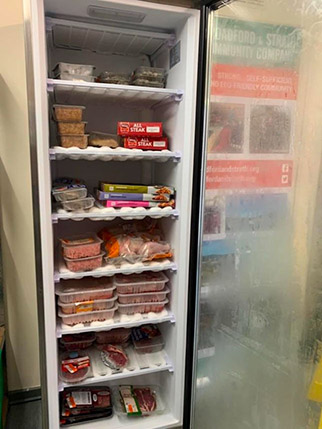
As the project evolved, there were 'gluts' of fresh produce which were sometimes difficult to make good use of. A chance discussion with a local hotel owner led to the offer of using the gluts to make meals which could be donated to those most in need. With funding from the Corra Foundation, BSCC paid for any additional ingredients that were needed to make the meals with, but the chef's time was given free of charge. Identifying people who would benefit most from cooked meals was difficult because of the need for anonymity, and UK GDPR regulations, but using other local networks, such as the foodbank and the local school cook (because of free school meals), BSCC were able to distribute the cooked food via these networks without any breaches of UK GDPR and confidentiality and reach those most in need. For instance, the school cook would take a quota of meals and distribute them on behalf of BSCC to those families that received free school meals.
"It was a funny time, on the one hand you were really wanting to help people, and on the other hand its GDPR and all this stress about random folk going up and approaching people and knocking on doors at a time we were being told to keep our distance."
Need was not necessarily associated with poverty, but with social isolation and vulnerability of one kind or another. One recipient, an elderly lady whose family were all on the mainland and who was in danger of being socially isolated, contacted BSCC to say she did not 'need' the meals, as she had enough money to buy her own food. She was told that it was not about financial need, necessarily, but about reducing food waste and making sure older people were looked out for and were getting access to nutritious food. She was so grateful that she made a donation to BSCC which was enough 'to pay for everyone's meals for the week'. Almost 5,000 meals were made in total, with an average of 120 a week being produced.
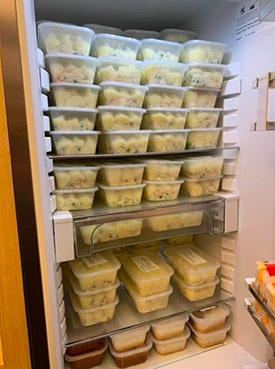
At some point during the first lockdown, food parcels were made available by the government, but these did not include fresh fruit or vegetables. BSCC supplemented these parcels with fresh produce from the supermarket waste and/or the produce grown at BSCC's Growers Hub. Fruit however was not so readily available so when a local business ran a fundraiser for BSCC it was decided by the board to start an orchard for the community, ensuring available fruit for the community on a long-term basis.
Volunteers dropping off food were able to establish a relationship with the recipients, and so there was a wider benefit of being able to bring some social contact for isolated people. Through these relationships, volunteers could check up on the recipients more generally and make sure everything else was alright. Using local knowledge and contacts, a lot of thought was put into the pairing of volunteers with recipients to get the most out of the relationship for all concerned. So, for instance, a local nurse who was volunteering was paired with those that had health needs so that she was able to do an informal check on the recipients.
"Not everybody that got a meal was in food need, but socially they were quite isolated. Our weekly meals were such a lovely, lovely experience. It gave us something to do in lockdown, it was the highlight of our weeks to be honest. The volunteers built up a relationship with the people that they were delivering to and as well as delivering food they would have a chat, see if they needed help with anything else. I made sure we paired the recipients with the right volunteer but I could only do that because I had local knowledge, it made it so much easier. One of our volunteers was a retired nurse, so if there were folk we were worried about we had her on hand."
Although the work was mainly done by volunteers recruited as part of the project, BSCC staff were key in getting it set up, recruiting and training volunteers, matching volunteers to recipients, and overseeing the whole project. In order to get the project off the ground, funding was sought from a number of sources. As well as covering some staffing costs for BSCC, funding also allowed them to purchase their own fridges and freezers, another polytunnel, purchase a storage container for the foodbank to store supplies, fund coordinators to set up the fridge, and recruit and train volunteers and to put systems and procedures in place.
"In some ways we tried to take the minimum we could run on and wanted to show very solid things for what we got. There was a lot of volunteer input and in some ways you were nervous about taking the money. We wanted to make sure we got the most of any funding we received in such difficult times. Had we had more core staff in place prior to the pandemic we could have done even more but as it was we did what we could with the capacity we had at the time."
The funding sources included:
- Supporting Communities Fund (Scottish Government) - £23K
- Corra Foundation - £2k
- COOP COVID-19 Funding - £5k
- Response Recovery & Resilience Fund (Foundation Scotland)- £5k
In making applications for funding for the project, BSCC were determined that any investment would have lasting value beyond the pandemic – they did not want to invest in anything that would not have a longer-term benefit for the community. They were also cautious and frugal, not wanting to have funding for anything that they did not need, and also wanting to have solid things that they could point at that were a result of the funding.
"There is an excellent legacy of the fridge being set-up…That was one of the key points for Broadford and Strath, that it wasn't just something that would disappear as soon as the crisis was over…there is a complete cycle of food management which wasn't in place before and there are better relationships or new relationships and networks forged within the community."
Local businesses also supported them, from the initial offer of storage from the Co-op, through the hotelier making meals, to nine months electricity donated by a local estate agent for the fridge, and a free "home" for the Community Fridge for a period. Various businesses and voluntary groups also wanted to fundraise to help out – a local jeweller auctioned off of a necklace and the proceeds were used to purchase an orchard, and the local football team fundraised for a contribution to the £2,000 for the additional ingredients needed by the hotelier for the meals.
The main period of activity of meal preparation and delivery was the first lockdown, but some aspects have continued beyond then, with the Community Fridges and the additional polytunnel continuing to be used. By October 2021, 948 volunteers had redistributed a minimum of £118,500 worth of food and supported some 9,480 people through the Fridge alone. As well as putting food in the fridges, BSCC also contact the school to give them surplus fruit, for instance, to distribute to children as play pieces.
What next?
The Community Fridge and foodbank are now well established in the village of Broadford, and there is also a community fridge in the Sleat area. Both are well used and will continue into the future, with BSCC collecting the food from the Co-op and managing the Broadford Community Fridge on a daily basis. The Sleat Community Fridge is managed by the Sleat Community Trust.
The additional polytunnel that was bought with the funding has added to the community resource of the Growers Hub, which is once again accessed by groups within the community. On Saturdays during the summer, the community is invited in to come and pick salad leaves through 'Salad Saturdays', encouraging the community into a space that they might not ordinarily visit.
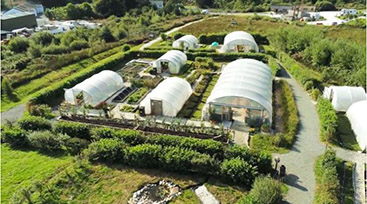
The legacy of the combined community fridge and foodbank has been a good result, and there are aspirations within the community for a 'community supermarket', where people would pay a regular small membership fee in exchange for a bag of groceries each week. It could become almost like a farm shop and be expanded to include local growers and producers.
A lot of the volunteers that came forward have continued to be involved in BSCC, but in a different capacity rather than delivery of meals. The food projects have also increased the visibility of BSCC, and they are now looked to, to get involved in all sorts of new areas in the community. This could potentially have a resource implication for BSCC as they are a small team without any real core funding.
"Going forward, rebuilding community networks which have been devastated by Covid, because that's what built the community resilience in the first place."
Reflections - success factors
Having local people on the ground was vitally important as it was the local connections and networks that enabled the project to be so successful, both in terms of getting people involved, mustering resources, and reaching clients.
"The absolute key to the projects all working was local knowledge and local connections and local networks. Absolutely cannot overestimate the importance of that."
They feel the project had a huge impact, both in terms of reducing food waste, and addressing food poverty and social isolation in the community. There are still around 20 people attending the fridge daily. The food waste continues to be generated, and sometimes this can be as much as 20 large boxes a day. It all goes – there is never any food left.
A further factor in the success of the project was by taking an approach that was about reducing food waste rather than addressing food need, it was possible to address issues around stigma. This enabled them to help a lot of people that might not have otherwise come forward. But a lot of people had lost their income source, especially if this came from the tourism sector, and the 'open to all' approach enabled everyone in the community to benefit. Maintaining focus on the core purpose of BSCC also helped them to look at the long-term benefit that any activities would have.
Having local control and freedom to do what they felt was necessary was also a key element of the success of the projects, and the flexibility around use of the grants helped in this respect: it helped them to focus on meeting local needs, rather than having to deliver on objectives which had been set for the average issues at a national level.
The project has raised local awareness of BSCC and the Growers Hub and changed the perception of the organisation in the community. They are now asked to be involved in lots more things locally, but they do not always have the resources to do this.
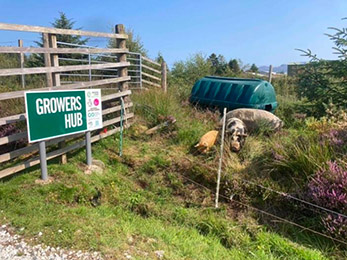
Lessons learned
Reflecting on their experiences, it was clear that the communities were not ready; there was no plan in place for a pandemic but there is a need to have a plan for this type of thing in the future. For islands, the prospect of food shortages, whatever the cause, are very real. There was a lot of effort made by the community and this needs be more cohesive on a larger scale should a similar type of emergency happen again.
Having flexibility from funders as to how to use the grants received was very valuable, especially when things evolved and new opportunities and ideas came up.
Social interaction was key. The pandemic left an older generation disconnected because of the reliance on technology such as Zoom. At the other end of the scale, young people lost all the usual opportunities to network and socialise and this has had an impact.
It was also acknowledged that communities in Skye were not ready for this type of emergency and that further measures would be needed to help manage future emergencies. It would be very valuable to have a learning debrief to look into what was done and how it was done. BSCC will do this for their own purposes, but to have something co-ordinated at a Skye level would be very valuable.
"Communities aren't ready. There was no plan. There was no emergency plan for a situation where we had food shortages and people were unemployed, for a pandemic essentially. There wasn't a plan. You need a plan. that is the biggest learning point. So many things swung into action which was fantastic and amazing and a wonderful community effort."
What community resilience means to BSCC
From the perspective of BSCC, community resilience is about the community being able to look after itself, and being able to withstand something that occurs unexpectedly, or even expectedly: being able to respond to a crisis.
Community resilience was very much seen to be built through networks and relationships. Some of these have been eroded by COVID-19, and they need rebuilt. For instance, networks are built by parents getting to know each other outside the school gates, or a community being galvanised round a local fundraising event. These all help build community resilience and they have not been able to take place through the pandemic.
Piece of advice to other communities
BSCC were asked what advice they would give to other island and rural communities to make them more resilient in the future, and they stated that it was key to be very aware of local networks and connections. These connections and networks need to be actively nurtured and developed, to build resilience, trust and knowledge. Having a local-level plan for emergencies was also important, so that people know what to do when things go wrong.
They also advised communities to look at what has been done elsewhere, and not reinvent the wheel.
Benefits – intended and unintended
There have been many different strands to the success and impact of the project:
- Mental health benefit for beneficiaries and volunteers. Many of the volunteers have spoken about the benefits to them – it filled a vacuum during the lockdowns, and gave them a real sense of purpose.
"One of the big things was a mental health benefit during lockdown, not just for the people receiving food but for the volunteers who were involved in the projects. That sense of purpose and usefulness and their own community impact. And the new networks that volunteers that made and the really strong friendships amongst volunteers."
- New friendships that developed. People are now missing this. The deliveries provided personal contact for people – they were like "the travellers of old, taking news from village to village".
"It was really important because for the meals that were being delivered, for some people receiving parcels, it was the only social contact they would have in a week."
- Savings on waste food and food miles.
- Savings for the Co-op in not having to pay to landfill food.
- Bringing together the fridge and foodbank has been a really good idea, which was a slightly novel idea at the time.
- Children's health – in some cases, better food now going to households with children, especially households with low incomes. They focused on children in households where there were other issues such as addictions, or young carers. They looked at getting food to children who were carers and getting food that they could make for themselves.
- Legacy of the infrastructure that they put in place with the funding (polytunnel, pigs, etc.).
Contact
Email: Emma.McCallum@gov.scot
There is a problem
Thanks for your feedback